We have a strict honest review policy, but please note that when you buy through our links, we may receive a commission. This is at no extra cost to you.
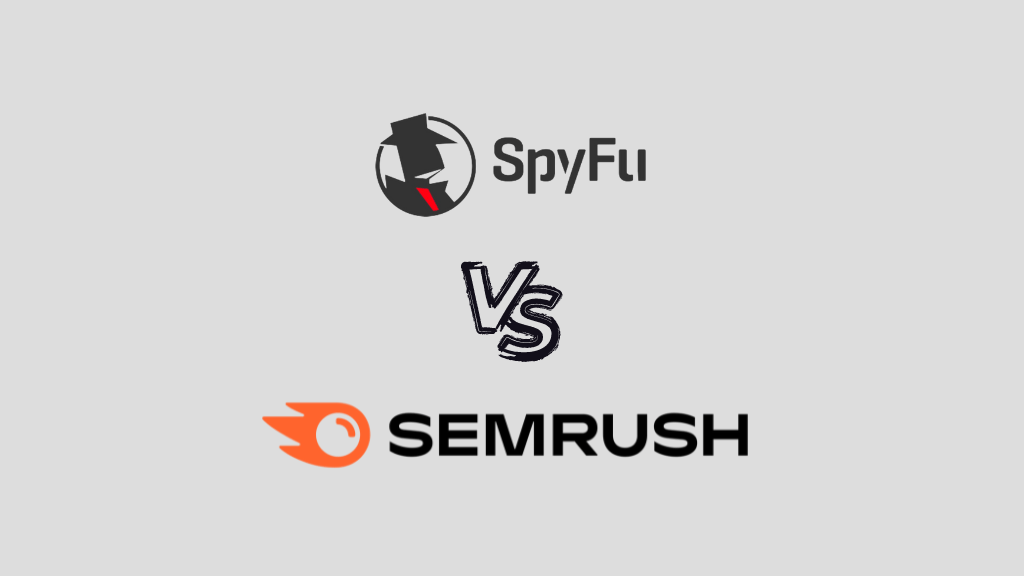
In this SpuFu vs Semrush comparison, I look at two of the most popular SEO tools available — and help you work out which one is right for you. I’ll cover…
- Domain analysis
- Keyword research features
- PPC research features
- Backlink analysis
- Site auditing
- Broken link analysis
- Ease of use
- Pricing and value for money
- Support
…and more.
Let’s start with a key question…
What are SpyFu and Semrush?
SpyFu and Semrush are two platforms that help you optimize your website for search engines.
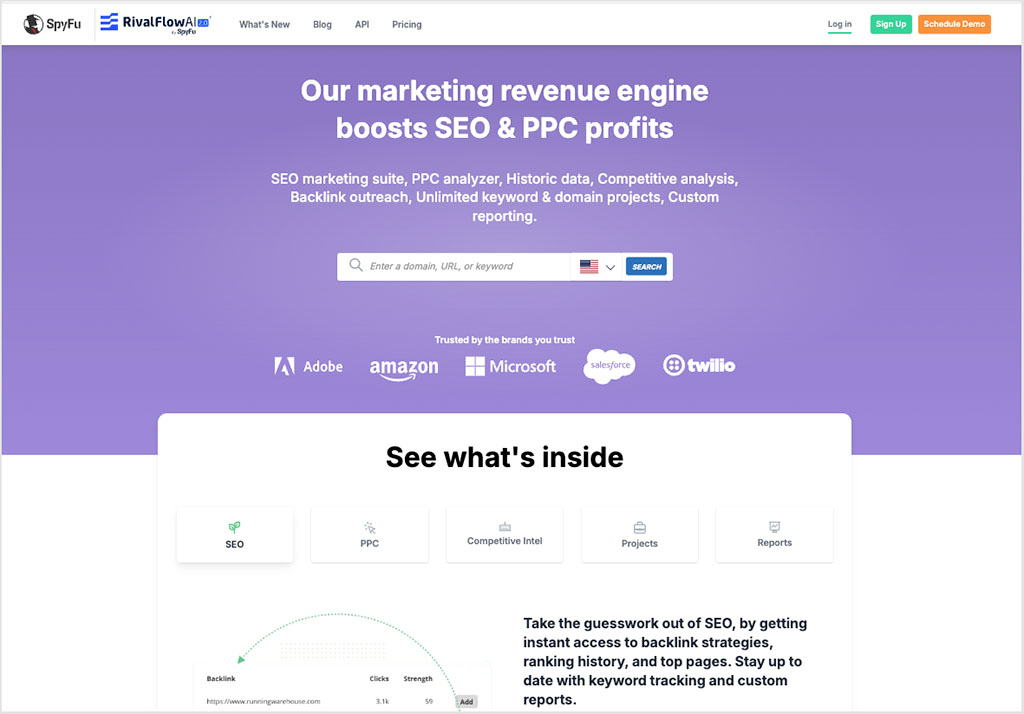
They do this in lots of different ways, but the main thing they give you is information — information that you can use to:
- discover exactly what people are searching for in your business’ niche
- create new content that will attract organic search traffic
- identify link-building opportunities
- change technical aspects of your website in ways that will help it rank higher in search results.
Both tools provide you with keyword ideas — based on phrases that you enter — that can be used to create engaging blog posts that are more likely to rank highly.
They’ll also tell you how heard it will be to rank for specific keywords.
And they’ll help you identify websites to approach for backlinks.
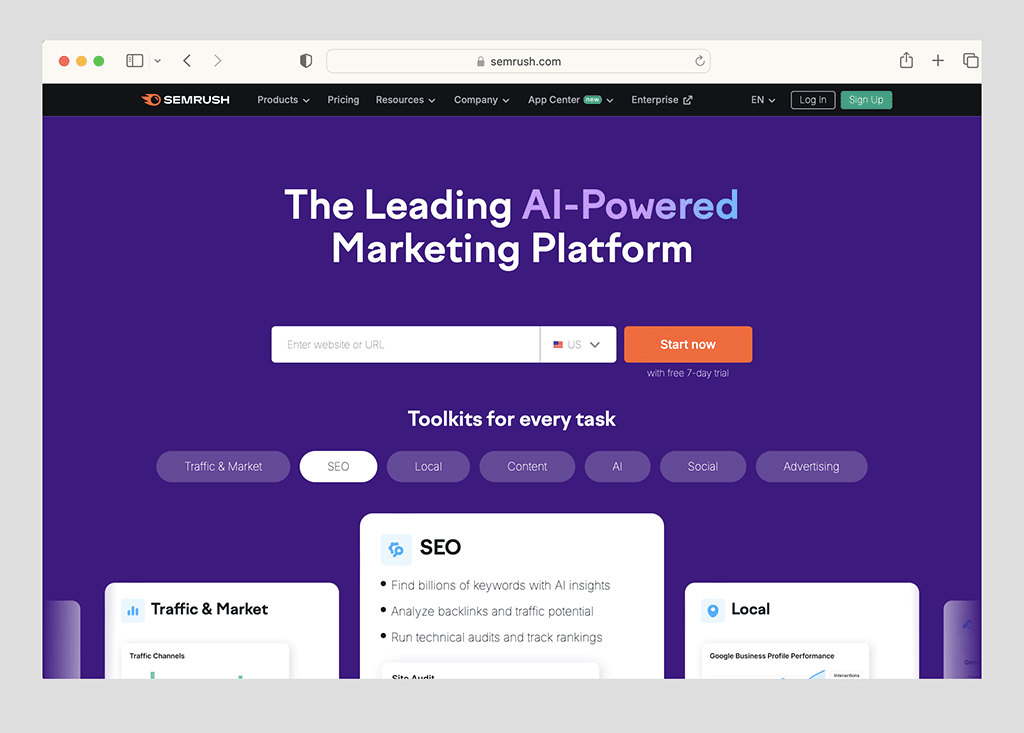
I’ll go through all these features in depth as I progress through this comparison — beginning with something called domain analysis.
Domain analysis
One of the most useful things you can do with SpyFu and Semrush is domain analysis.
This means getting a general take on how a website is performing from an SEO point of view.
You typically perform domain analysis either on your own website — to see where SEO improvements could be made to it — or on a competitor’s, to see how hard it will be to outrank them in organic search results.

Carrying out domain analysis is straightforward in both SpyFu and Semrush — you just enter a domain into a ‘domain overview’ section and and key metrics are returned quickly, in a dashboard format.
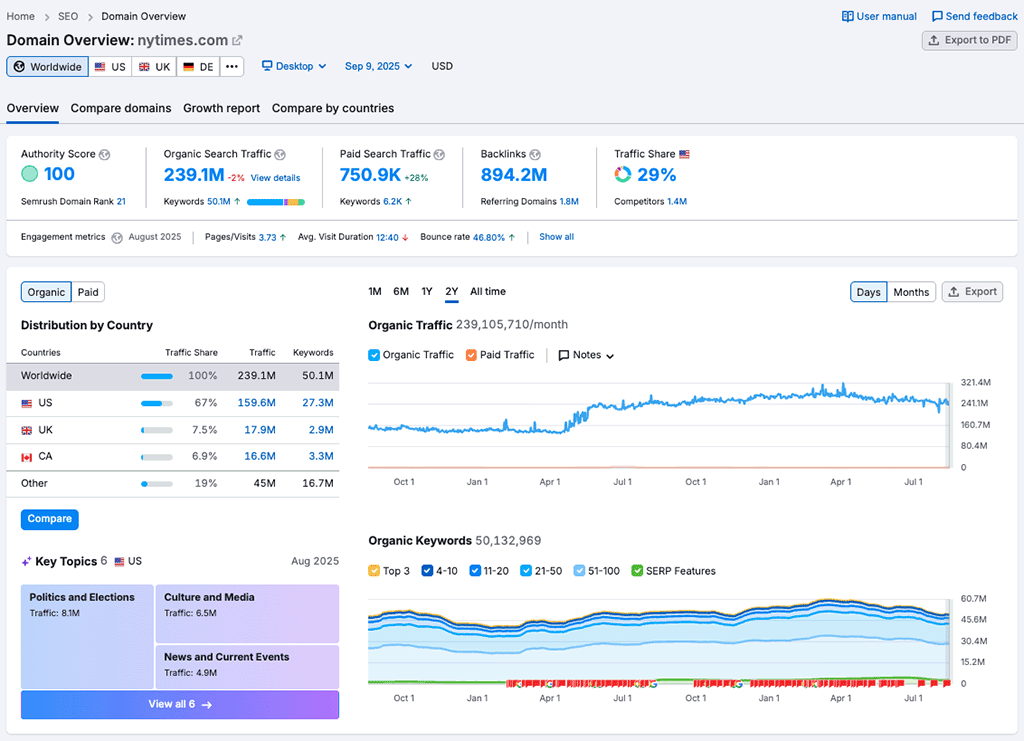
With both tools, metrics provided include:
- An estimate of the total number of organic visitors to the website each month.
- An estimate of the amount of paid search traffic to the website each month.
- The total number of keywords the website ranks for.
- The top keywords the website ranks for.
- A list of key competing domains.
Semrush gives you some pretty important metrics that you won’t find in SpyFu’s domain overview dashboard, however.
Chief amongst these is an authority score — a piece of data that tells you, at a glance, how ‘powerful’ a domain is from an SEO point of view. The higher the score for a domain, the more likely it is that content placed on it will rank highly, or that a link from it will positively influence the rankings of a site being linked to.
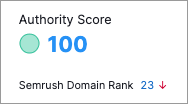
(That said, there is a ‘domain strength’ metric available in some SypFu reports. For example, if you look at a backlink report for a domain, you’ll see this beside each linking domain listed. But weirdly, SpyFu doesn’t show you an authority score for the actual domain you’re investigating!).
Then, there’s search intent data. Semrush doesn’t just tell you about the number of keywords a site ranks for — it also gives you information about why people are using them during searches.
Its ‘keyword by intent’ box breaks down the type of keywords that a site ranks for into four categories: informational, navigational, commercial and transactional. These tell you what a user is trying to do when performing a search (find information, locate something, buy a product etc.).
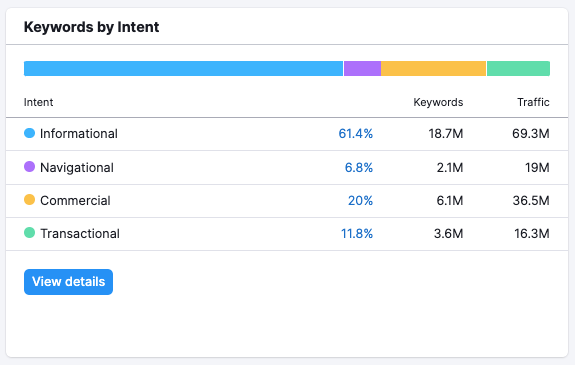
I’ll cover search intent in more depth shortly, but for now I’ll just say that it comes in very useful in SEO, and there’s nothing really comparable from SpyFu in its domain overview.
Another key difference between Semrush and Spyfu’s domain overview tools is the number of countries you can perform domain analysis for. While Semrush shows you how a domain is performing in circa 120 countries, SpyFu limits you to doing so with 28 territories.

And unlike Semrush, SpyFu doesn’t let you get a global overview of domain data — you have to do things on a per-country basis. This stops you from getting a more holistic view of a domain.
As you can see in the screenshot below, Semrush gives you a simple ‘worldwide’ option which, when clicked, gives you an analysis of a domain at a genuinely global level.

Traffic analysis in SpyFu and Semrush
As part of their domain overviews, both SpyFu and Semrush give you reports showing the monthly traffic to the domain you’re looking at — but it’s important to note that the figures provided here are estimates.
Unlike SpyFu, however, Semrush gives you an indication of how accurate the estimates are likely to be — high, medium or low. (You’ll need to navigate to a separate ‘traffic analytics’ tool to access this data however — it’s not displayed on the domain overview.)
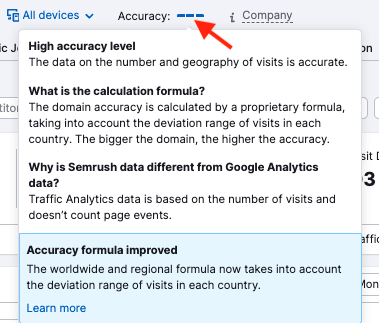
And, as discussed above, SpyFu doesn’t give you a ‘global’ view of a domain’s data. This causes particular headaches when it comes to traffic estimates, because you’ll only ever see a partial view of how much traffic is going to a site.
During my own testing and research, using sites for which I have access to visitor data, I found that Semrush’s estimates were the more accurate of the two — although in several cases, not terribly so!
(In general I’ve found Semrush’s estimates to be more accurate when sites with higher traffic levels — typically 50k+ — are being examined.)
In truth, the important thing to remember with either set of traffic statistics is that they are best used to identify trends (i.e., is site A more popular than sites B and C?) — rather than being taken as gospel. But of the traffic estimates returned, Semrush’s are more useful, mainly because you can use them to get a sense of global traffic levels to a website.
Overall, both Spyfu and Semrush will give useful insights into the SEO peformance of a domain. But due to its more comprehensive data, its global overviews and the provision of an authority score, the winner here is definitely Semrush.
Now, let’s take a look at keyword research features — a very important aspect of both platforms.
Keyword research features
Keyword research involves four key processes:
- Establishing how many people are searching for a particular keyword
- Establishing how difficult it is to rank for that keyword
- Finding out who is already ranking for that keyword
- Getting suggestions for other ones.
And both SpyFu and Semrush make it fairly easy to to carry these tasks out.
In both platforms, you just enter a phrase into a keyword overview tool and you’ll get the info you need straight away — search volume for that phrase, its keyword difficulty score, the sites that are currently ranking for it and a list of related keywords.
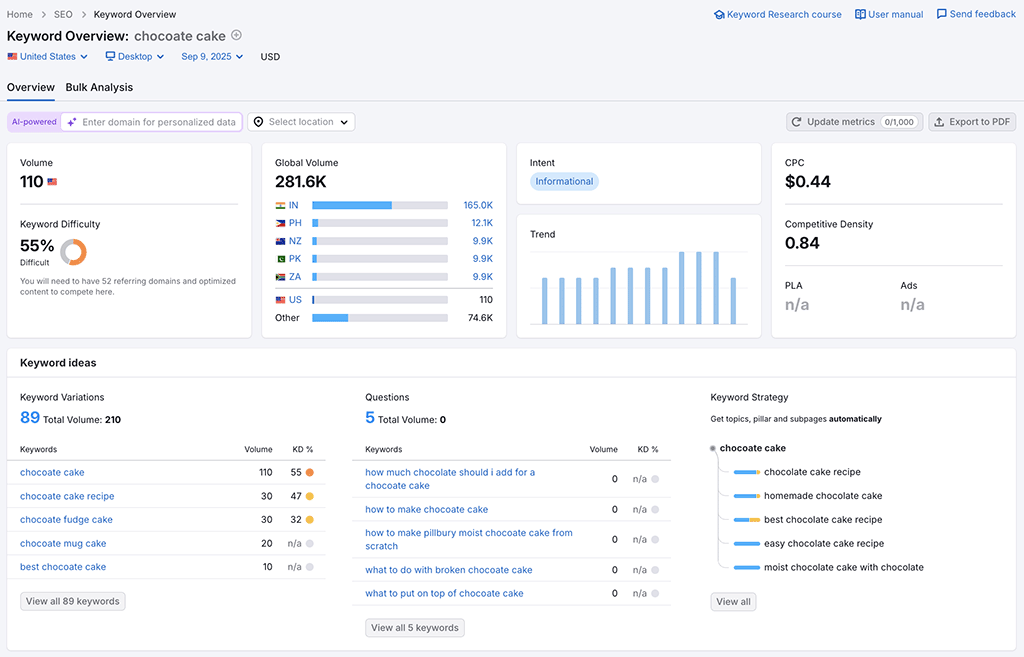
Both platforms use scores out of 100 to indicate keyword difficulty — with a higher percentage indicating higher difficulty.

However, with Semrush, you get more context about keyword difficulty — not only do you get you a general score that indicates how hard it will be to rank for a keyword, you’re also told how many backlinks you’ll need to for it to rank in the top ten search results on Google).
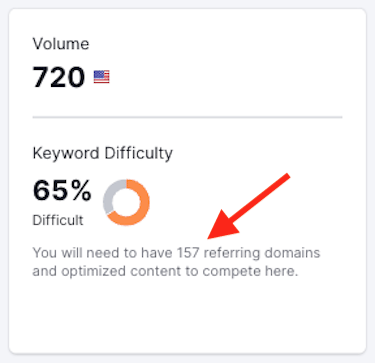
(Google effectively treats backlinks as votes — the more high-quality links you have pointing to a piece of content, the more likely it is to rank highly in search results).
You also get a feature that I’ve yet to come across in any other SEO tool I’ve tested: a ‘personalized keyword difficulty score.’ This tells you not just how generally difficult it will be to rank for a particular keyword, but how difficult it will be for your site to rank for it. Semrush figures this out based on how topically relevant your website is for the keyword you’re looking at, and the strength of your domain.
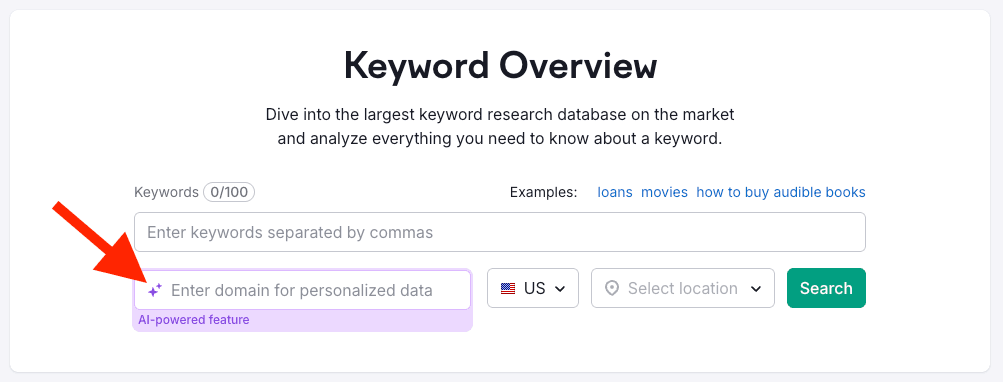
How do SpyFu and Semrush calculate keyword difficulty scores?
The way that SpyFu and Semrush calculate keyword difficulty is rather different.
Semrush examines quite a lot of different parameters when calculating it — including the number of backlinks pointing to top ranking sites, country, the word count of a keyword, whether or not a keyword is branded and search volume.
SpyFu, by contrast, focuses mainly on backlinks pointing to sites ranking highly for particular keywords (and the quality of those links).
During my tests of both platforms, I ran a few keywords through both tools to see if they were consistent in identifying particular phrases as easy or hard to rank for. Here are some examples from my results:
| Phrase | Sypfu difficulty | Semrush difficulty |
|---|---|---|
| Beatles albums | 34 | 67 |
| Blue iPhone case | 17 | 33 |
| Chocolate cake | 23 | 82 |
| Chromebook | 50 | 89 |
| Google Workspace | 42 | 100 |
| Harry Potter | 66 | 100 |
| Les Paul guitar | 29 | 45 |
| Pancake recipe | 25 | 84 |
As you can see from the data above, my tests revealed a large discrepancy between how hard SpyFu and Semrush think it will be to rank for keywords (on a broad range of topics).
In each test, SpyFu flagged the keyword involved as being easier to rank for than Semrush did.
To benchmark this data, I ran the keywords through another SEO tool, Ahrefs (another well-respected SEO platform), to see what Ahrefs made of them from a difficulty perspective.
In effect, I wanted Ahrefs to be a judge of sorts. And, in six out of my eight tests, the Ahrefs keyword difficulty score was considerably closer to the Semrush score than the SpyFu equivalent.
Although we’re talking about a small sample of data here, my impression based on these tests (and from playing around with SpyFu’s keyword research tool in general) is that SpyFu tends to downplay keyword difficulty at times, especially where branded keywords are involved.
Getting keyword suggestions
When you look up a keyword in SpyFu and Semrush, in addition to being presented with the the ‘difficulty’ metrics discussed above, you are also given access to a wide range of keyword variations — alternative phrases that you might want to consider using in an SEO campaign.
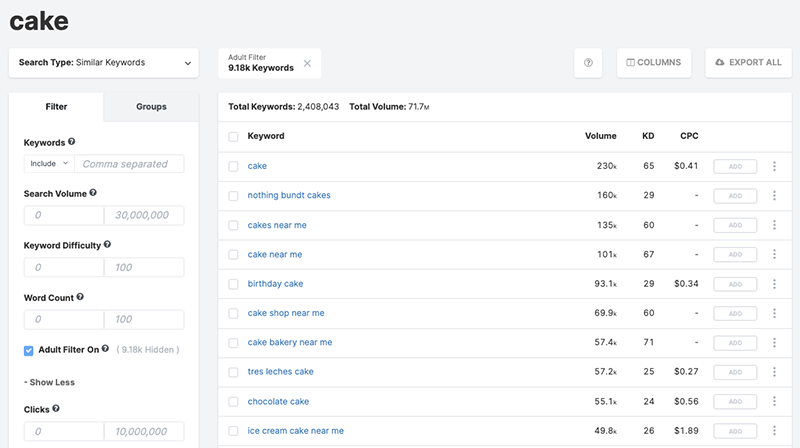
In SpyFu, you use the appropriately-named ‘Related Keywords’ tab to access this data; in Semrush, you click on its ‘Keyword Magic’ tool.
When testing keyword suggestion features, I found that both tools returned large and relevant lists, with the number of suggestions returned by Semrush for a given keyword typically being larger.
This is not surprising, given that its keyword database is considerably bigger than SpyFu’s — it contains 27.3 billion keywords to SpyFu’s 7 billion.
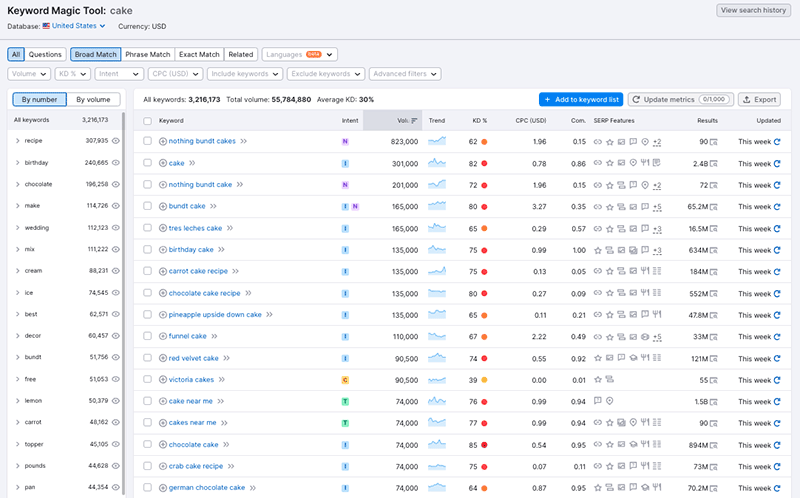
The other thing you get more of with Semrush when it comes to keyword suggestions is contextual data. Each keyword suggestion in Semrush is accompanied by nine additional pieces of data, namely:
- search intent
- search volume
- the trend of searches over time
- keyword difficulty
- cost-per-click value
- PPC competitive density
- SERP features
- the number of search results for a keyword
- the date that it was updated in Semrush’s database.
(If using Semrush’s personalized data feature, you’ll also see a personalized keyword difficulty score and a ‘potential traffic’ metric that lets you estimate how much traffic you’d get if you created strong content for the keyword you’re investigating).
By contrast, SpyFu accompanies its keyword suggestions with just three pieces of contextual data — search volume, keyword difficulty and cost-per-click value.
In terms of the filters that you can use to narrow down your keyword suggestions into realistic targets, both platforms give you a good range of options here, with Semrush giving you a few more options (18 filters to SpyFu’s 15).
Unlike Semrush, SpyFu gives you quite a few filters relating to ad campaigns — you can filter by things like the percentage of paid clicks through to a particular keyword, or the total number of advertisers bidding on a particular phrase.
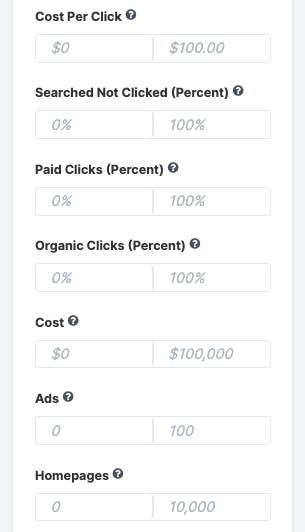
Semrush’s filters are more to do with sifting through organic search results — and give you more fine grain control over things like format (broad match, phrase match, exact match, question etc.), language and search intent.

And speaking of search intent…
Identifying search intent
As discussed briefly earlier, Semrush gives you more context about why users perform particular searches than Semrush, thanks to its very useful ‘search intent’ feature.
As part of the metrics returned for a particular keyword, you’ll see an ‘intent’ box highlighting the context in which a particular search is made:

In the example above, you can see that for a search phrase of ‘Microsoft 365’, Semrush thinks that the intent behind the user’s search is likely to be ‘navigational.’
Semrush also automatically highlights when the search intent is likely to be ‘transactional’,’informational’ or ‘commercial.’
These types of keyword search intent are defined by Semrush as follows:
Informational = user wants to find a specific answer to a question
Commercial = user wants to investigate brands or services
Navigational = user wants to find a particular page or website
Transactional = user wants to complete an action (i.e., make a purchase or complete a form).
There’s nothing really comparable from SpyFu on this front, so it’s a definite win for Semrush here.
Now, Semrush’s keyword intent feature really comes in handy when you’re filtering keyword suggestions.
When you enter a phrase into Semrush’s ‘Keyword Magic’ tool, you’ll typically end up with a huge list of suggested phrases, and it can be hard to spot the phrases that are most likely to generate revenue for you.
But Semrush’s ‘intent’ dropdown menu helps massively here, because it lets you exclude a lot of irrelevant stuff really easily and focus on the phrases that are most likely to be lucrative for your business.
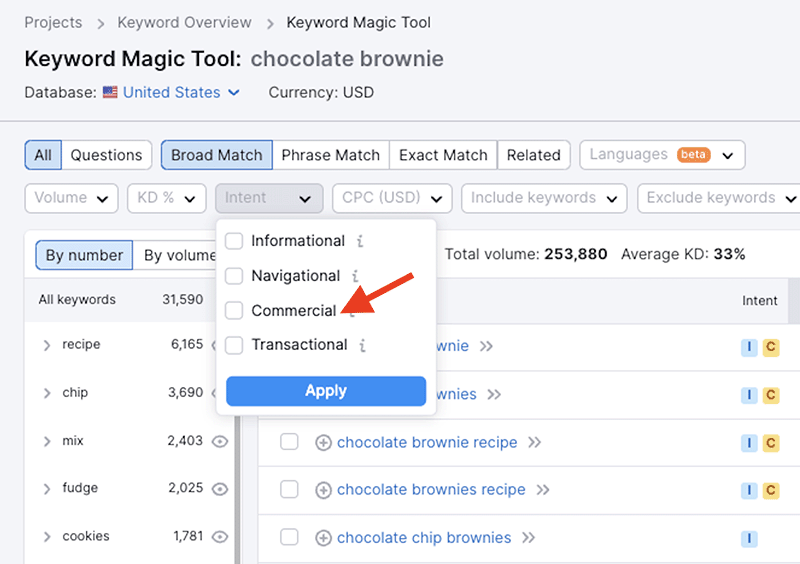
As a simple example of this, you could simply filter keyword suggestions by ‘commercial’ intent to view those that are most likely to lead to purchases.
Although SpyFu does provide some help resources on identifying search intent, it doesn’t give you a comparable feature, so it’s another clear win for Semrush in this area.
Keyword lists
Semrush allows you to create lists of organic keywords that you can refer to any time you like, using its ‘Keyword Strategy Builder’ tool (pictured below). This lets you create lists of target keywords and keep tabs on their evolving difficulty scores and search volumes.

Recently, Semrush has enhanced this feature by adding a ‘keyword clustering’ feature to it. You can use this to get Semrush to either:
- suggest topic clusters based on a keyword you enter
- organize your keywords into topical clusters (pillar pages and subtopic pages)
The aim of this feature is to help make the process of establishing ‘topical authority‘ on a website — where you cover a topic in an exhaustive and logical way — quicker and easier.

(Google can give preferential treatment to sites that are clearly authorities on certain topics, and contain a lot of content focused on topically relevant phrases).
I like this ‘clustering’ feature, but I think it needs a little bit of work — some of the results can be a little bit off target.
SpyFu lets you build keyword lists too, but the process for doing so is quite confusing. Rather than just being able to create individual lists based around topics of your choosing (as is the case with Semrush), you have to associate them with particular domains and ‘projects’.
And, when you do so, your keyword list — known as a ‘Keyword Universe‘ — is pre-populated with a lot of keywords that SpyFu thinks should be on your list (based on the content on your domain). This can be useful — but also a nuisance, depending on your aims. You can create ‘groups’ of keywords within a ‘Keyword Universe,’ which serves as a workaround, but overall the process is clunky and not remotely as intuitive as Semrush’s.
Additionally, SpyFu’s keyword lists don’t display keyword difficulty scores, making them considerably less useful than the Semrush equivalents.
So, when it comes to creating and managing keyword lists, it’s another clear win for Semrush.
What search engines do SpyFu and Semrush pull data from?
So far in this comparison, we’ve seen Semrush winning out in the keyword research department. However, SpyFu does have one advantage over its rival in this area, in that it lets you access data from more search engines. While Semrush only provides data for one search engine, Google, SpyFu gives you some organic ranking history data from Bing, which you can access when viewing a project.
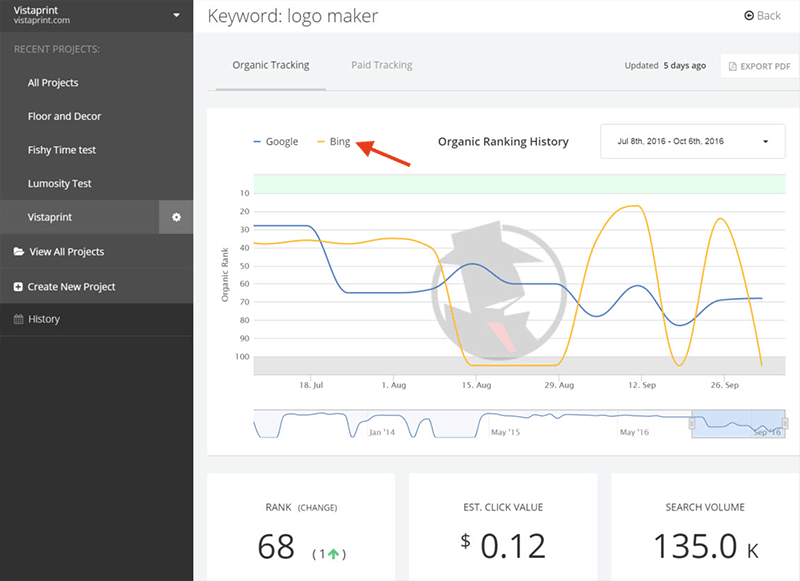
Now to be fair to Semrush, the emphasis on Google is pretty understandable, given its current dominance of the search engine market — 89.83% at time of writing (source: Statcounter).
And the Bing data you get from Semrush is pretty limited too — you won’t get search volumes or keyword difficulty scores for Bing, just some rank tracking data.
But nonetheless, the presence of some additional search engine data in its platform does represent a bit of a win for SpyFu.
Pay-per-click (PPC) research features
In addition to letting you access data relating to organic search results, both Semrush and SpyFu let you access a considerable amount of Google pay-per-click (PPC) data. Both are considerably better than key rivals Ahrefs and Moz for this purpose.
In SpyFu, a dedicated ‘PPC research tab‘ gives you access to a wealth of data about the ads currently being run by a particular domain (and key competing ones).

Metrics and tools available from SpyFu in this section include:
- the paid keywords currently being used by a company
- traffic being generated by those paid keywords
- the cost for using those keywords
- key competitors bidding on the same keywords
- a history of the PPC ads that the company you’re researching has run
- suggestions on what keywords to bid on
- campaign templates for use with Google Ads
To access PPC data in Semrush, you go to its dedicated ‘Advertising’ tab, where you can access a range of similar features.

In terms of the key differences between SpyFu and Semrush’s PPC research tools, one edge that SpyFu has over Semrush is its ‘Google Ads Advisor’ feature. This quickly surfaces a list of PPC keywords that SpyFu thinks you should consider bidding on (based on competitor activity and cost).
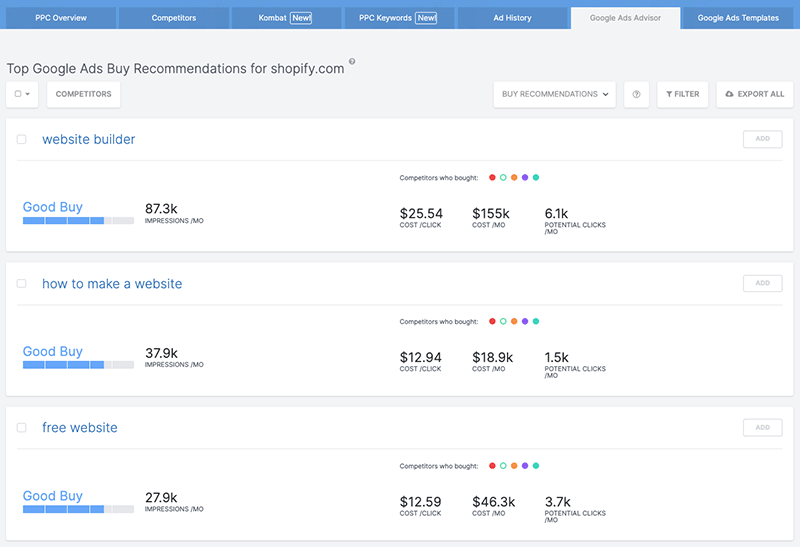
Another nifty feature offered by SpyFu for which there’s no direct Semrush equivalent is its ‘Google Ads Templates’ tool. This works with the downloadable Google Ads Editor and aims to give you ‘ready-to-import’ Adwords campaigns based on criteria you specify.
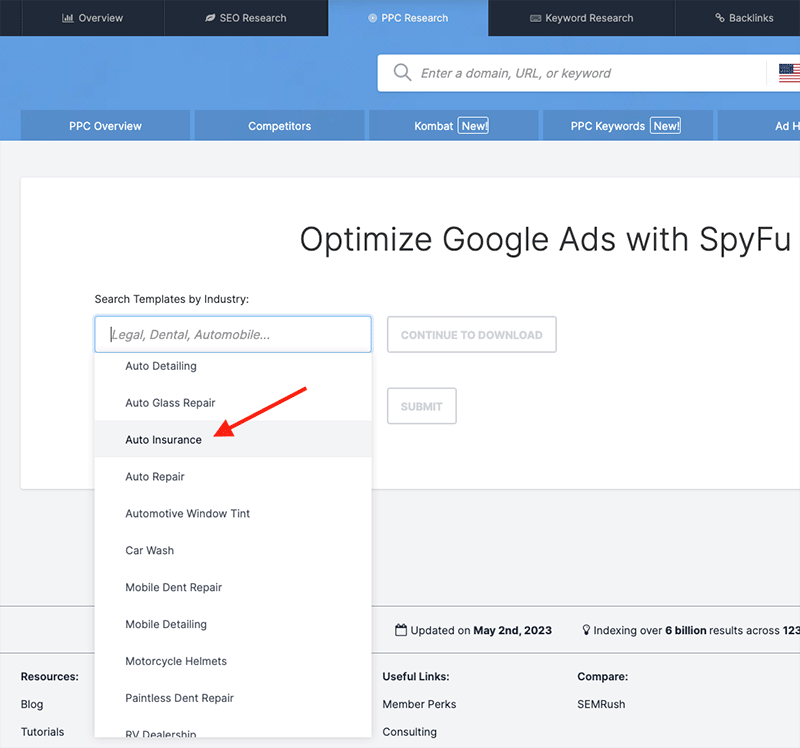
SpyFu also wins in the PPC department when it comes to ad history — at time of writing, 19 years of data is available to draw on (which compares positively with Semrush’s 13 years of history). This ad history data informs the PPC keyword suggestions that SpyFu provides, and the keywords included in its ads templates.
Semrush is no slouch in the PPC department, however, and provides some advertising research features that are not available in SpyFu.
Most significantly, Semrush gives you the option to conduct advertising research for services other than Google — you can, for example, use a paid-for third-party app like ‘Ad Assistant’ or ‘AdClarity’ to research and optimize advertising opportunities on other platforms (including social media).
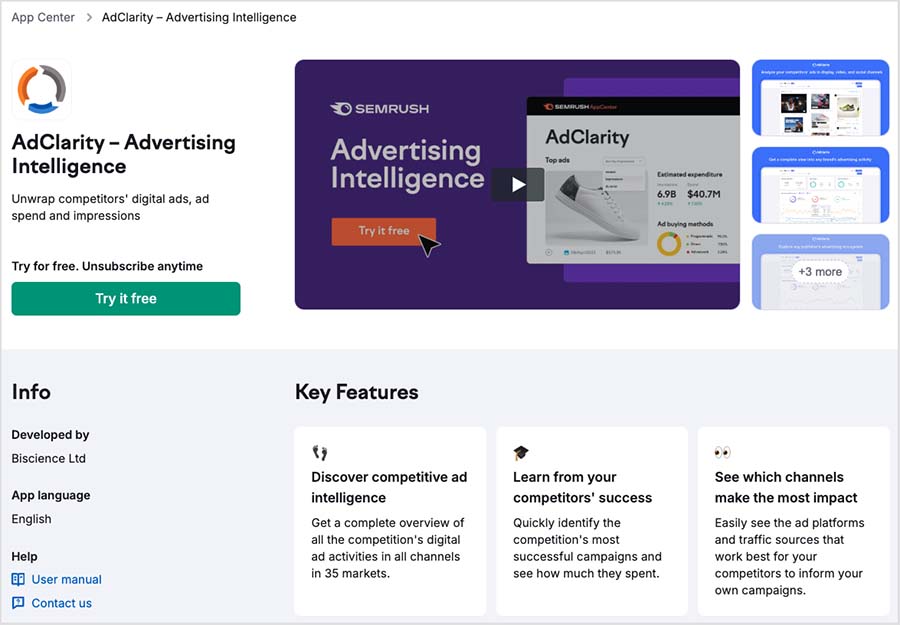
And finally, Semrush has a dedicated section for analysing Google’s ‘Product Listing Ads’ (PLA). These are the product ads that typically appear in carousel format at the top of Google search results (see screenshot below for an example of some of these).
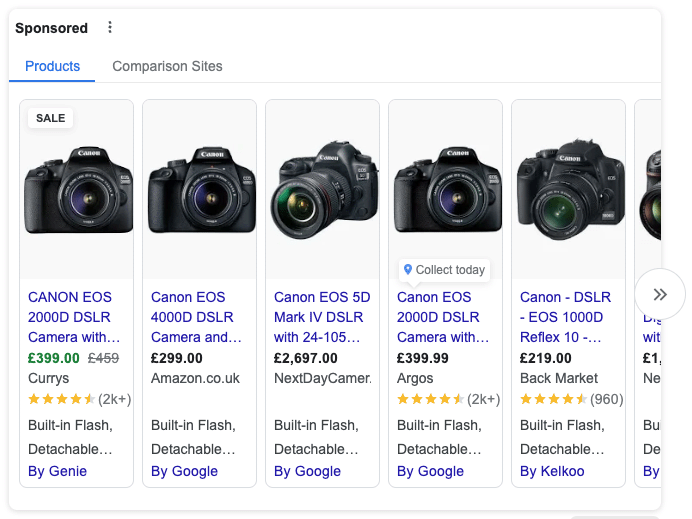
You can enter a domain into Semrush’s advertising dashboard and get a detailed list of PLA ads that are being run by a particular company (along with the keywords used to place them).
Overall, when it comes to PPC and advertising data in SpyFu and Semrush — and unlike the other features we’ve discussed so far — the products are pretty closely matched, both giving you lots of useful data about advertising campaigns.
The key advantage that Semrush has in this department is flexibility — you can access data about more campaign types using the tool (albeit sometimes at a price, via paid-for third-party apps).
SpyFu’s advantage here is that it gives you access to comprehensive PPC data at a much lower price point than Semrush (I discuss pricing in more depth shortly).
Content marketing in Semrush and SpyFu
In addition to providing SEO and PPC research features, Semrush also provides content marketing tools.
These come in the form of a ‘content marketing platform’, which helps you:
- identify new topics to write about
- use an ‘SEO writing assistant’ tool to help you craft search-friendly content
- audit your existing content from an SEO point of view
- identify keywords that your competitors are using in their posts
Semrush also provides an ‘SE Writing Assistant’ feature; this works in a similar way to the increasingly popular ChatGPT tool, writing short sections of texts based on prompts you give it. In my tests I found this worked pretty well, especially when I was prompting it to create factual content.
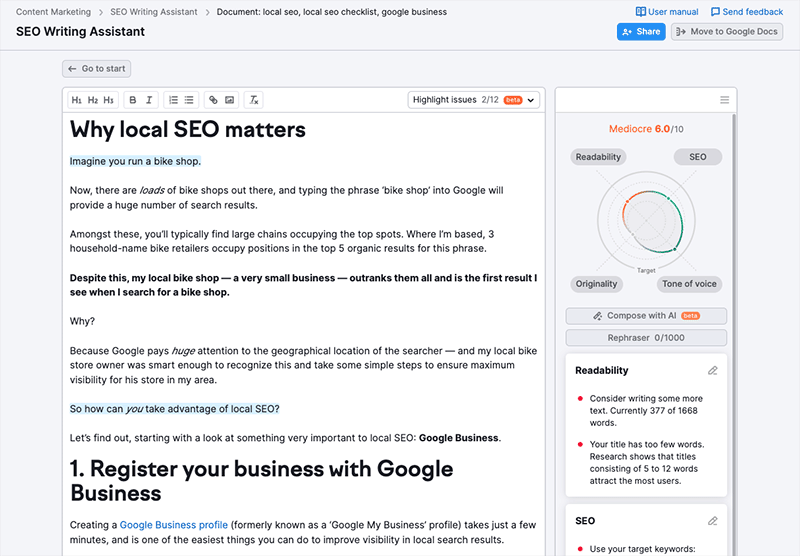
Helpfully, you can use this tool outside of Semrush: plugins for Google Docs, MS Word and WordPress are available for it.
In terms of limits, these depend on your subscription tier. Free users — and those on the Pro plan — can generate up to two documents per account. By contrast, users on the Guru or Business plans can create an unlimited number of documents each month.
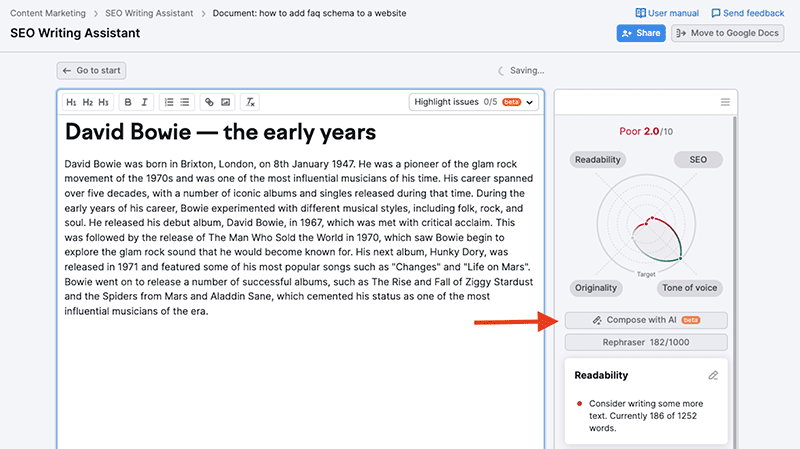
Ultimately Semrush’s content marketing tools are very helpful in quite a few contexts. However, you do have to be on a more expensive plan — Semrush’s $249.95 ‘Guru’ plan or higher — to gain access to them.
💡 Tip: Style Factory readers can access an exclusive 14-day trial of the Guru plan here.
As for SpyFu, there isn’t much in the way of built-in content marketing tools available from the platform, but the company behind the software has recently released a related AI writing tool, ‘RivalFlow AI.’ This costs between $79 and $199 per month to use.
RivalFlow AI looks at your content and gives you data on:
- questions your competitors answer that you don’t
- questions your competitors answer more thoroughly than you do
- questions you both answer.
Based on this information, you can adjust your content to make it more comprehensive and (theoretically at least) outrank your rivals.
Let’s take a look now at a very important aspect of SEO, backlink analysis.
Backlink analysis
How well a site performs in search results usually depends heavily on how many backlinks — external sites linking to it — exist for the site in question.
Both SpyFu and Semrush let you enter a domain name and view a list of all the backlinks to it that each tool can find.
Backlink database size
Based on the figures made publicly available by SpyFu and Semrush, Semrush’s database of domains is considerably bigger than SpyFu’s, containing 808 million domains to SpyFu’s 123 million.
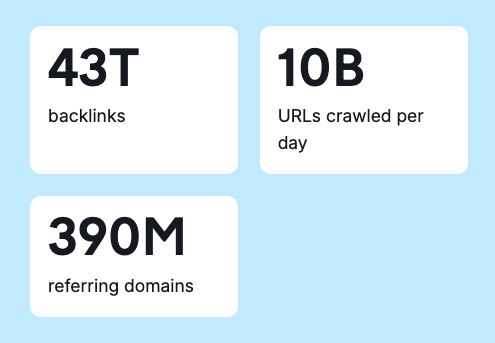
This means that in theory, Semrush should be able to provide more comprehensive data for analyzing backlinks.

I was curious to see how this played out in practice however, so I conducted some simple tests on both tools’ ability to surface backlinks. These involved running some of the websites for ecommerce and design tools that we review through both platforms.
Here’s the number of backlinks surfaced by SpyFu and Semrush in my tests:
| Website | SpyFu | Semrush |
|---|---|---|
| Amazon | 48m | 6bn |
| BigCommerce | 3.9m | 660m |
| Canva | 90k | 84.8m |
| Ecwid | 90k | 111m |
| Godaddy | 592k | 570m |
| Jimdo | 3k | 96m |
As you can see from the data in the table above, Semrush comprehensively beat SpyFu in terms of backlinks surfaced in all six contests.
Yes, this was a small test, but the results were consistent with other research I did into both platforms — whenever I pulled backlink reports using both tools, Semrush always gave me more data.
(Interestingly, I have run this test a couple of times now, with each test taking place a few months apart. While the number of links surfaced by Semrush changed every time the test was run, the SpyFu numbers remained static, indicating that its database may not be updated all that frequently.)
So when it comes to backlink database size, and the number of backlinks surfaced by both tools, it’s another win for Semrush.
Backlink reports and tools
In terms of the backlink analysis itself, Semrush give you LOTS of useful information about the backlinks that point to a domain, including breakdowns of:
- the number of ‘dofollow’ links vs ‘nofollow’ ones
- the country of origins of backlinks
- anchor text used
- new vs lost domains
- linking domain types (government, education etc.)
And Semrush presents this information nicely — simple but attractive graphs spell out the key stats in a way that helps you digest them easily.
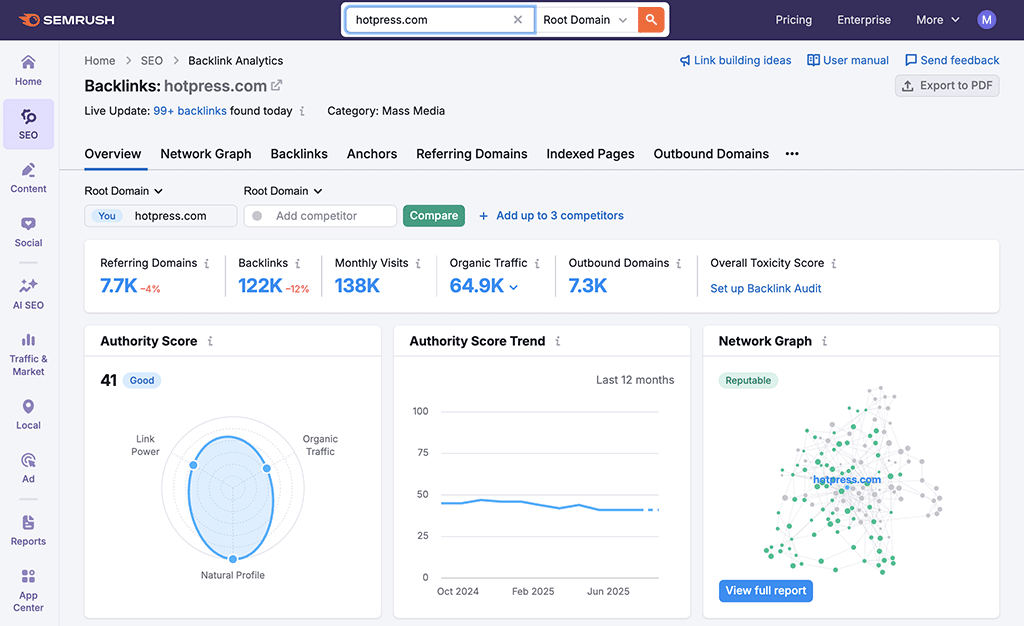
You won’t really get comparable data from SpyFu — the backlink reporting is extremely basic in nature. You do get the option to filter by backlink type (blogs, news, .gov sites etc.), which is helpful, and the ability to surface backlinks that might be relevant to particular keywords.
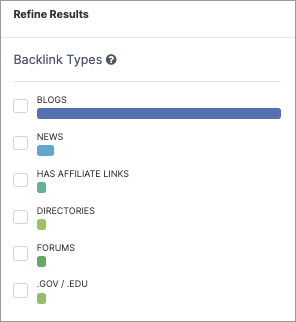
Semrush and SpyFu both give you ‘link intersect’ tools, which allow you to compare a URL from your website against those from competing sites, and gives you an exportable list of websites that are currently linking to your competitors, but not to you.
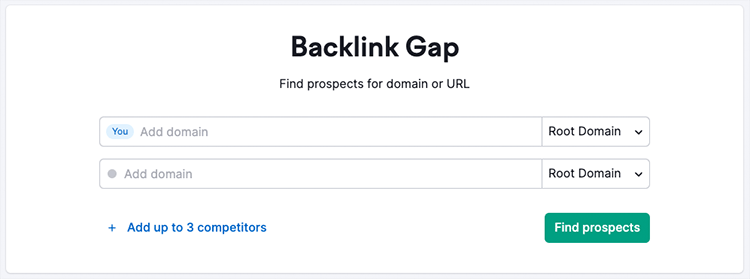
Both these tools work in similar ways, but Semrush’s is better — simply because it uses a much bigger link database to provide results.
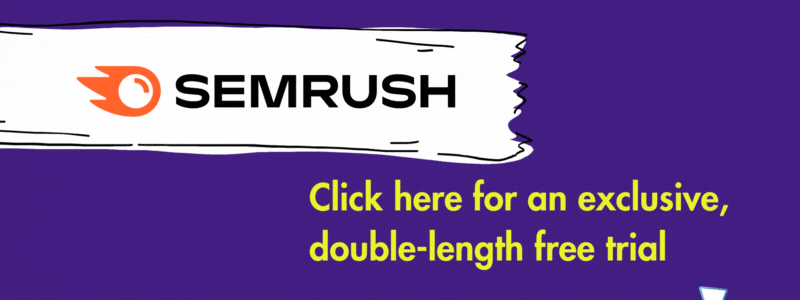
Backlink auditing and building
Semrush offers a couple of backlink-related features for which there’s no equivalent in SpyFu.
First, there’s a ‘backlink auditing’ tool which identifies ‘toxic’ links (spammy links that can lead to you being penalized in search results).
You can output a list of these links, which you can then upload to Google as a ‘disavow’ file (this asks Google to ignore them when ranking websites).
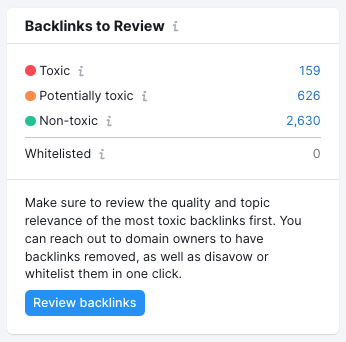
However, not all SEO professionals think that these sort of link spam identification tools are actually that helpful, and that a more manual approach to identifying poor-quality links works better.
And interestingly, Google’s Webmaster Trends Analyst John Mueller is not a fan of the concept of toxic links at all, or the tools that identify them!
So, although some users may find Semrush’s toxic link tool useful in highlighting suspicious backlinks, I wouldn’t really view SpyFu’s omission of a similar tool as a key reason to choose Semrush instead.
Semrush’s ‘link building’ tool is more useful, however. This analyzes your domain or URL and gives you a list of websites to target with a request for a new backlink.
What’s interesting about this feature is that you’re not dealing with a spreadsheet of URLs — you’re dealing with a more ‘CRM-style’ interface, with each domain listed as a ‘domain prospect.’
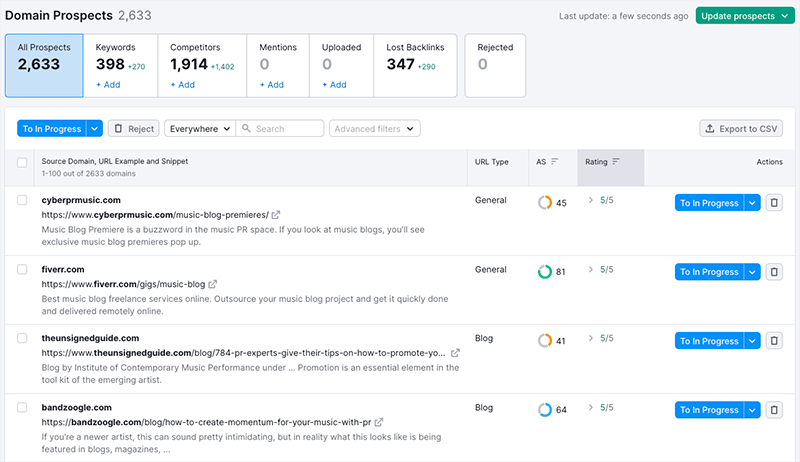
You can click on a button beside each domain prospect to move it into different stages of a link-building pipeline, and send outreach emails directly within the Semrush interface (by connecting your email mailbox to Semrush).
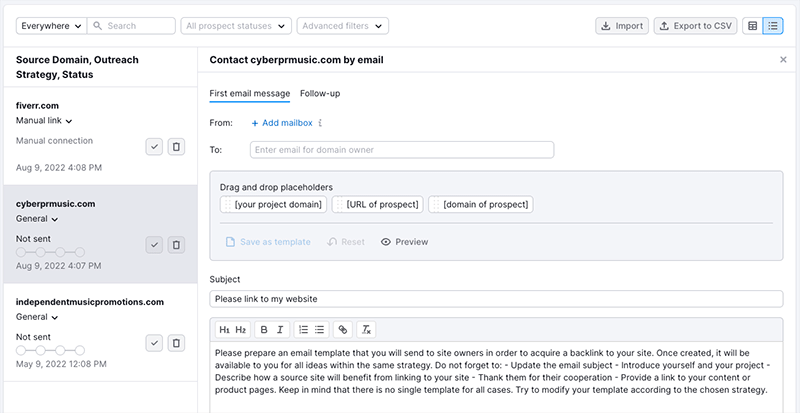
This is a lovely feature.
Now, SpyFu does give you a backlink outreach tool too — however, it’s a lot more basic.
First, rather than automatically suggesting websites for you to approach (based on a URL you enter), SpyFu needs you to supply your own list of target sites. Once it’s got that, it will try to surface contacts for these.
But when testing this feature, I found that while SpyFu occasionally managed to surface Twitter or Facebook profiles for websites, unlike Semrush it didn’t didn’t give me any email addresses (it’s technically capable of doing so — it just didn’t give me any results for the sites I was targeting).
And, while SpyFu does let you associate tasks with websites, you’re not talking about a fully-fledged ‘CRM’ tool (i.e., similar to the one that Semrush gives you).
So all in all, when it comes to backlink auditing and building, the better tool by far is Semrush.
Trying out SpyFu and Semrush before you buy
SypyFu doesn’t offer a free trial, but does give you access to a free version of the tool that lets you run a small number of reports.
Semrush, by contrast, offers an entirely free trial. Normally speaking, this trial lasts just 7 days — but for a limited time, there’s an extended, 14-day free trial available which you can access using this link.
Site auditing
Semrush provides ‘site auditing’ features that allow you to evaluate how well your site is performing from a technical SEO and on-page SEO perspective.
A site audit will highlight issues that might be having a negative effect on your search ranking, including:
- Slow-loading content
- Duplicate content
- SSL problems
- Crawl errors
- Missing headers
- Overuse of keywords
- Core web vital scores (site speed and stability metrics)
- Broken inbound links
It will also give you an overall ‘site health’ score along with a list of problems that you need to address.
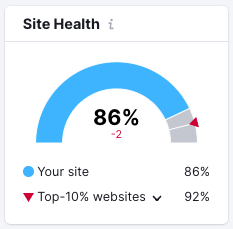
Each problem is accompanied by contextual help regarding the issue involved, and tips on how to find a solution.
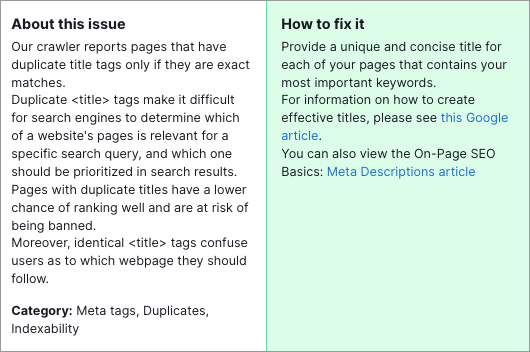
And in a nice touch, Semrush lets you export any problems it finds as tasks to the project management app Trello (you can also use Zapier to send them to other task management platforms).
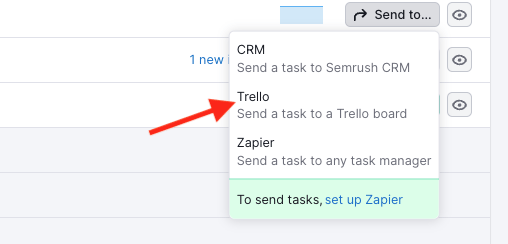
You can also send these tasks to Semrush’s own simple CRM tool, which is built into the platform.
I particularly like Semrush’s on-page SEO checker, which goes through your whole site and gives you actionable tips for improvement for each page (in order of priority).
These can include suggestions on:
- the best keywords to add to your content
- steps you can take to make a page appear as a Google ‘featured snippet’
- how to improve your body copy and meta descriptions
- websites to approach for backlinks
- the length of your content
- internal linking strategies…
…and more.
As for SpyFu, unfortunately there are no site auditing tools included in the platform at all, meaning that when it comes to identifying technical improvements you could make to your site, it’s yet another win for Semrush.
Don’t miss out on our free SEO toolkit
For a limited time only we’re offering our readers some excellent free SEO tools and resources. Sign up now to immediately receive:
- our downloadable cheatsheet containing the 20 key steps to ranking highly in search results
- extended free trials and discounts for leading SEO tools
- our downloadable cheatsheet on how to grow organic traffic to a blog
- 2 in-depth guides to SEO
- ongoing free tips and advice on SEO and growing your business
Broken link analysis
Broken link building in SpyFu and Semrush
Broken link building is an important SEO tactic.
It involves…
- finding a broken link (i.e., one that no longer leads anywhere),
- recreating the ‘dead’ content that it used to point to, and
- asking anybody who used to link to the dead content to link to yours instead.
This approach lets you build new backlinks to your content — and the more backlinks that point to your website, the better your content can perform in search.
In order to make this tactic work however, you need to be able to identify broken links — and the bad news for SpyFu users is that this is not possible with the tool.
By contrast, Semrush does have a broken link building feature — to access broken links, you run a backlink analytics report, navigate to an ‘indexed pages’ section and click a ‘broken pages’ option.
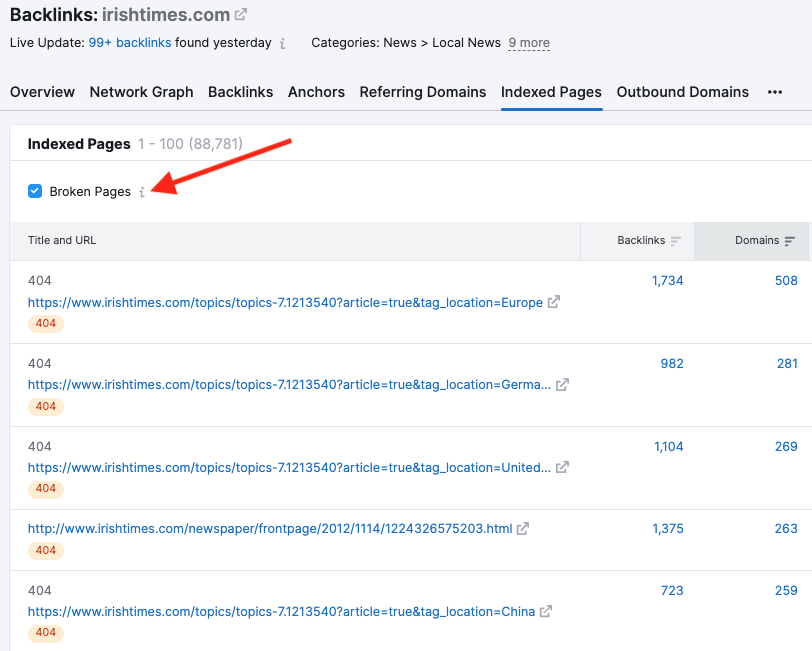
So, if broken link building is likely to be an important part of your SEO strategy, the better tool here is Semrush.
Identifying broken outbound links in SpyFu and Semrush
It’s also important to ensure that your web pages don’t contain broken links to other sites — these can be interpreted as a sign of poor quality content by Google (with negative implications for search rankings).
Again, Semrush wins over SpyFu here — because it provides you with a means to spot broken outbound links while SpyFu doesn’t.
In order to find broken outbound links with Semrush, you’ll have to run a site audit on a domain; once this is done, you go to the ‘warnings’ section of your site audit report, where you’ll be able to access a full list of problem outbound links.
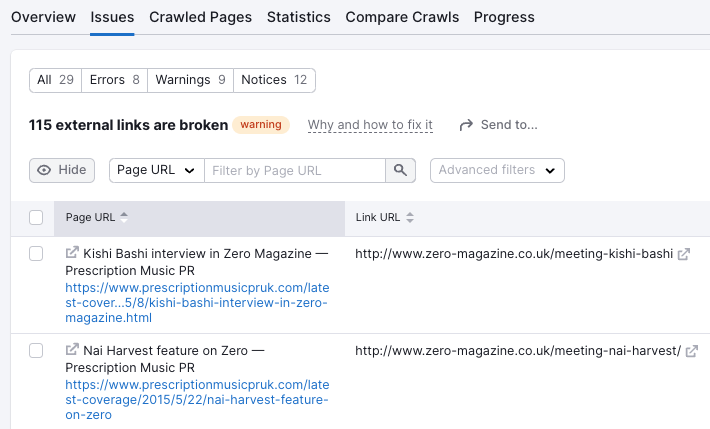
However, using this method of identifying broken external links will involve using one of your ‘project slots’, which isn’t ideal.
(More on project slots — what they are and why they matter — shortly).
Interface and ease of use
It’s probably fair to say that SpyFu is, in general, a bit easier to use than Semrush — it’s interface is less cluttered, makes use of large fonts and it’s very easy to find key tools. Simple tabs at the top of the screen let you navigate easily between features.
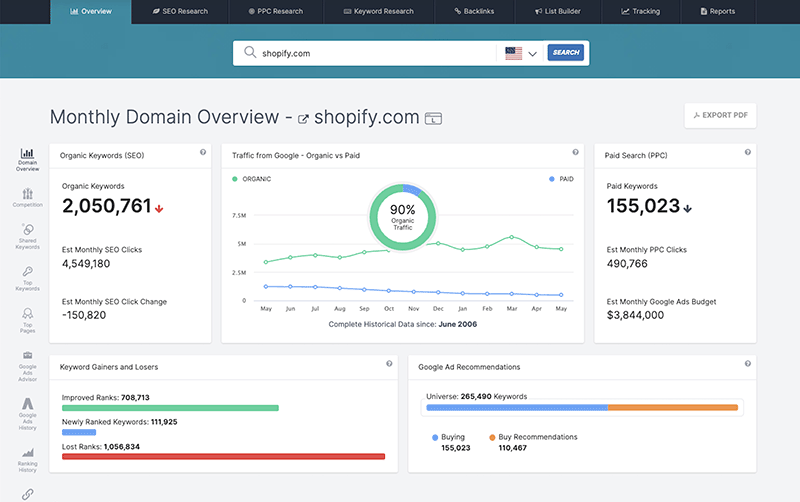
However, SpyFu’s ease-of-use is in large part down to the fact that it is considerably less feature-rich than Semrush — the reason that Semrush’s back end feels a bit busy at time is because you can do far more with the tool.
And, while testing these products I found that Semrush’s data loads considerably faster — sometimes it took a very long time for SpyFu to load data.
(For the record, this seemed to be more of an issue with organic search data than PPC data).
And, if you like data visualization, the Semrush approach will definitely appeal. It graphs just about every key piece of information you can think of.
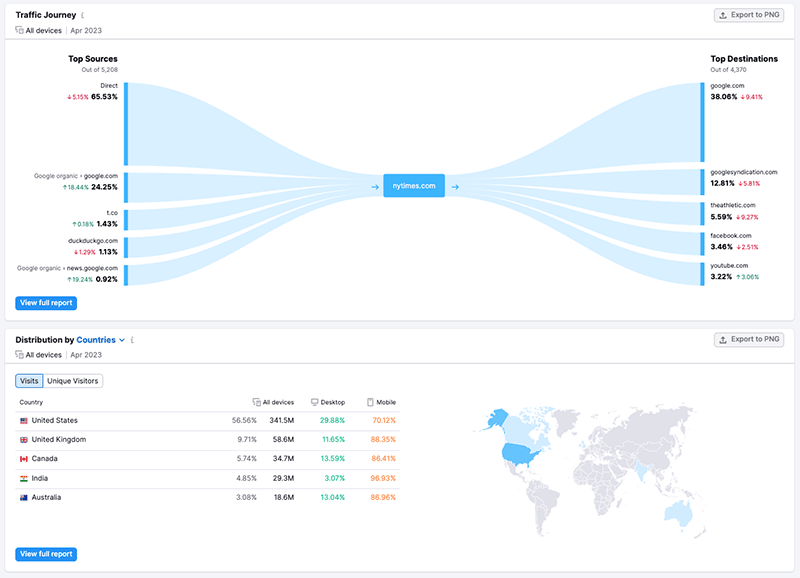
There is one UX area where Semrush definitely wins hands down in the ease-of-use stakes: outreach tools.
Its CRM-style approach to link building means that a lot of the time you can identify and contact prospects ‘in the box,’ whereas with SpyFu, it’s more a case of exporting data to Excel which you then reimport into other apps (contact finders, email marketing tools etc.) for outreach purposes.
Ultimately, SpyFu is easier to use when it comes to getting at-a-glance information.
But for detailed analysis, project-based work and link building, Semrush makes life much easier.
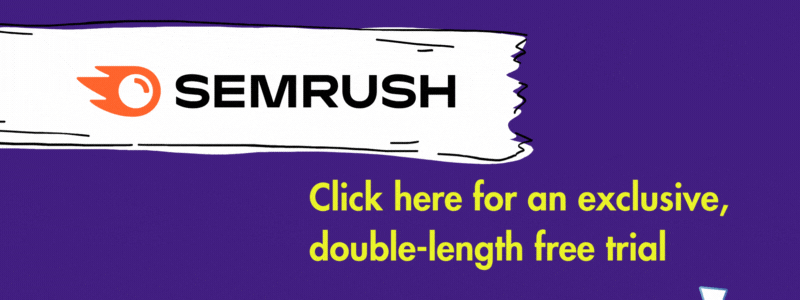
Pricing and value for money
Compared to other types of ‘SaaS’ (software as a service) apps, SEO tools can be very expensive.
That’s understandable however, as you’re not just paying for functionality, you’re paying for access to a lot of data, including some pretty serious competitive analysis data.

Semrush offers 3 main pricing plans:
- Pro: $139.95 per month
- Guru: $249.95 per month
- Business: $499.95 per month
There’s also the option of creating a ‘custom’ Semrush plan — fees for this are negotiable, as are features. And an ‘Enterprise’ plan is also available (again, with negotiable fees).
A discount of up to 17% is available if you pay on an annual basis, and there’s also a free trial available.
SpyFu comes in 2 varieties:
- Basic: $39 per month
- Professional: $79 per month
If you pay upfront for a year, these fees are reduced dropping to $33 and $58 per month respectively.
So as you can see, SpyFu can work out considerably cheaper than Semrush.
(Further ‘lifetime’ discounts are currently available for SpyFu if you sign up for the platform and then start a free trial of its ‘RivalFlowAI’ product, an AI-powered content analysis tool.)
There isn’t a free trial available for SpyFu, but you can make use of a free version of the tool — one that limits you to pulling just a few reports.
In terms of which product is better value, this will depend on your business requirements (and budget).
That said, there are a few key things to zoom in on when trying to work out which offers the most bang for the buck for you. Let’s take a look at these now.
Number of users
By default, all Semrush plans only come with one user account. If you want more seats, you have to pay an additional monthly fee to add additional users to a plan ($45 per month per ‘Pro’ user, $80 per month per ‘Guru’ user and $100 per month per ‘Business’ user).
It’s not that clear at the moment what the situation with multiple user access is on SpyFu. There used to be a ‘Teams’ plan that let you work with five seats for $149 per month — but seems to have disappeared from the SpyFu pricing page, and neither the ‘Basic’ or ‘Professional’ plans support multiple users.
So I reached out to the SpyFu customer support team to see if they could clarify the situation regarding multiple logins, and was told that users can be added for an additional fee of $15 or $30 per month on a ‘basic’ or ‘pro’ account respectively (see screenshot below).
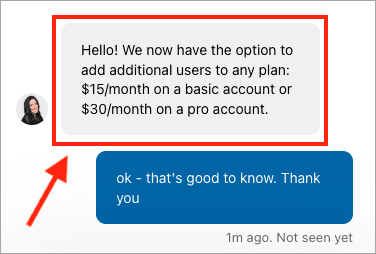
Projects
It’s important to be aware that some features in Semrush and SpyFu can only be used on domains that have been added as ‘projects.’
Key Semrush features that fall into this category include site audits, backlink audits, link prospect identification, on-page SEO checking and rank tracking.
Key SpyFu features that require a project slot include creating keyword lists and surfacing contacts for link building.
Now, with Semrush, how many projects you can have on the go depends on the plan you’re on — the entry level plan, at $139.95 per month, facilitates 5; the ‘Guru’ plan 15 and the ‘Business’ plan 40.
By contrast, there aren’t any limits on project slots in SpyFu at all (but that said, what you can actually do with a project in SpyFu is much more limited).
Rank tracking
Rank tracking (also known as position tracking or SERP tracking) lets you track a website’s daily rankings for a custom set of target keywords.
And SpyFu’s rank tracker is more generous. Its ‘Basic’ plan lets you track 5,000 keywords and its ‘Professional’ plan lets you track 15,000.
The equivalent limits across Semrush’s plans are much less generous — 500, 1,500 and 5,000 on its ‘Pro,’ ‘Guru’ and ‘Business’ plans respectively.
So if rank tracking is a big part of what you do, you’ll find SpyFu to be the better value option here.
Historical data
SpyFu gives you access to historical data more cheaply than Semrush.
You have to be on a $249.95 ‘Guru’ plan or higher to get access to it in Semrush, while SpyFu gives you 6+ months of historical data on its $39 per-month ‘Basic’ plan and full access to its 19 years of data on its other ones.
However, what you have to remember here is that Semrush’s database is much bigger than SpyFu’s — so with Semrush, you’ll be dealing with historical data that is better from both a quality and quantity point of view.
Semrush toolkits
Semrush makes a number of additional features available via paid toolkits. These bundle together specialist tools for different aspects of digital marketing.
The Traffic & Market toolkit (formerly Semrush .Trends) costs $289 per user per month and provides competitive intelligence tools. It combines Market Explorer, Traffic Analytics, One2Target and EyeOn, giving you estimates of audience demographics, market share, traffic sources and competitor activity. These are best used for spotting trends and relative performance, rather than as exact numbers.
The Social toolkit helps with content planning and publishing. Prices range from $19.99 to $39.99 per month depending on how many profiles and AI-generated posts you need. The entry-level version covers scheduling, reporting and competitor tracking; the higher tiers add AI-powered content ideas and unlimited scheduling, making them more suitable for agencies or heavy users.
The Local toolkit is aimed at businesses with physical locations. At $50 or $60 per month, it lets you push your details to directories, manage Google Business Profile and Facebook listings, track local rankings and monitor reviews. The premium version adds faster review updates, improved Google Maps tracking and API access. For ecommerce or online-only businesses, it’s less useful.
Finally, there’s ImpactHero, which now sits in Semrush’s ‘extra tools’ category. At $200 per user per month, this AI-powered content analytics tool evaluates your assets across different customer journey stages, highlights top-performing content, visualizes your conversion funnel and suggests improvements.
The Semrush App Center
In addition to purchasing one of the the Semrush toolkits discussed above, you can also add features to your Semrush account by paying for a third-party app. These are available from the ‘Semrush App Center.’
At time of writing, around 60 apps / integrations are available. Their focus is mainly on analytics and data, and they range in cost from $10 to $349 per month, per user.
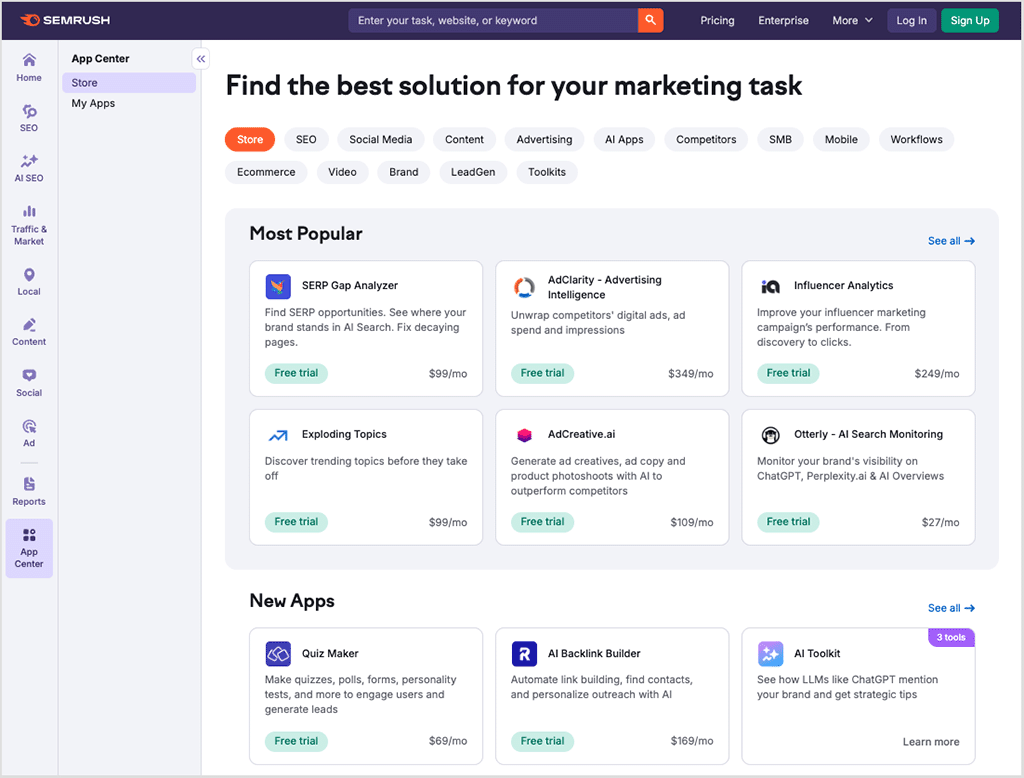
Key apps in the Semrush app store include ‘Influencer Analytics,’ an app that’s designed to make finding influencer/content creator partners for your site easier, and ‘AdClarity,’ an app that gives you a 360 degree view of your competitors’ advertising activity across multiple advertising platforms.
SpyFu doesn’t provide a similar app store — but if you’re on its ‘Professional’ plan, you can use its API to integrate it with other applications.
Reporting limits
SpyFu is more generous when it comes to the number of reporting requests you can make each month, allowing you to pull unlimited reports on its ‘Professional’ plan, and 10,000 of any type of report on its ‘Basic’ plan (per month).
Semrush technically limits things a bit more tightly — but that said, it’s still one of the most generous SEO tools on the market when it comes to reporting (especially by comparison to key competitor Ahrefs). For example, even on its entry level plan, you can run 3,000 keyword reports per day — which in practical terms probably feels like unlimited reporting.
And you have to remember of course, that the quality of reports you can pull in Semrush is considerably higher than the SpyFu equivalents — as we’ve seen throughout this comparison, the amount of data you get from Semrush is much more comprehensive. The variety of reports you can pull in Semrush is much greater too.
PPC
If you’re working exclusively on PPC projects, SpyFu is arguably the better value tool. It gives you a very comprehensive set of Google Ad related tools for a considerably lower price than Semrush.
However, if you’re happy to pay extra for Semrush — in the form of third-party apps — you’ll find that you can use the tool to do more comprehensive advertising research (i.e., research that is not limited to just Google ads but display advertising services too).
Social media
You can use Semrush to gain insights on social media activity related to your brand or a competitor’s. The platform connects to key social networks and gives you access to a dashboard that provides insights on followers, post reach and post engagements. You can also use these social media tools to schedule posts.
These features are basically online marketing tools (rather than SEO ones), and will probably be viewed by many users as a ‘nice to have’ option rather than an essential piece of functionality. But if you feel that a social media tracker or post scheduler is important to you, then you should note that there’s nothing really comparable from SpyFu.
Customer support
Semrush and SpyFu offer a similar level of customer support, both providing three channels of support: phone, live chat and email.
This offering is more comprehensive than that offered by key rivals Moz and Ahrefs (which more or less limit you to email support).
Both Semrush and SpyFu make it easy to contact support — there’s a support icon present at the bottom right corner of both interfaces. Semrush’s phone support is easier to get at however, thanks to a phone number shown prominently in the footer (you’ll need to be logged into your Semrush account to see this, however).
User reviews
Up to this point, I’ve outlined my own perspective on SpyFu and Semrush. But it’s also worth looking at what users on independent review sites are saying.
The table below brings together ratings from major software review platforms (accurate as of September 2025):
| Review site | SpyFu | Semrush |
| Capterra | 4.5 out of 5 (144 reviews) | 4.6 out of 5 (2,305 reviews) |
| G2 | 4.6 out of 5 (513 reviews) | 4.5 out of 5 (2,908 reviews) |
| TrustRadius | 7 out of 10 (131 reviews) | 8.7 out of 10 (766 reviews) |
| GetApp | 4.5 out of 5 (144 reviews) | 4.7 out of 5 (2,300 reviews) |
| Average user rating | 4.40 | 4.63 |
Both SpyFu and Semrush enjoy solid feedback across review sites, but Semrush consistently comes out ahead. The difference is especially noticeable on TrustRadius, where Semrush’s rating is significantly higher.
Free trials
As discussed above, with SpyFu, no free trial is available, but a free plan with limited access to data is available.
Semrush, by contrast, allows you to try the product out entirely free via a free trial. Normally speaking, this lasts just 7 days — but for a limited time, the company has made an extended double-length trial available. You can access this via this special link (note that you’ll need to enter your credit card details to start your trial, but so long as you cancel at the end of it, you won’t be charged).
Additionally, Style Factory readers can avail of exclusive, 14-day free access to the Guru trial via this special link.
SpyFu vs Semrush: conclusion
So which is better, SpyFu or Semrush? The answer is Semrush. It’s a much more feature-rich and capable tool that can be used to drive real improvements in organic traffic to a website. Yes, it’s considerably more expensive than SpyFu, but the quality of its data is higher, its database is much bigger and you can perform a much wider range of SEO tasks with it.
There is one area where SpyFu arguably wins, and that’s in its provision of detailed PPC data at a much lower price point than Semrush. Users on a low budget who only ever work on paid search campaigns may find that SpyFu represents the better-value choice.
But if you work on SEO, or a mix of SEO and PPC, the better option is unquestionably Semrush.
If you’ve got any thoughts on your own on Semrush or SpyFu, do click here to leve a comment — I’ll do my best to answer them!
Pros and cons summary
Reasons I’d recommend using SpyFu over Semrush
- It’s considerably cheaper, especially if you use it in conjunction with its standalone ‘RivalFlow AI’ tool.
- It gives you access to historical data on all its plans.
- Unlimited reporting is available on its ‘Professional’ plan.
- So long as you’re on its most expensive plan, you get access to multiple user accounts (Semrush limits you to one seat on all plans unless you pay for additional users).
- Its rank tracking limits are more generous.
- Its Google Ads template feature, for which there’s no Semrush equivalent, has the potential to speed up PPC campaign creation considerably.
- It’s arguably a bit easier to use (although not where keyword lists or identifying domain authority are concerned).
Reasons I’d recommend using Semrush instead of SpyFu
- Semrush’s feature set is much more comprehensive.
- Its backlink database is bigger and better than the SpyFu equivalent.
- It gives you easier access to domain authority data.
- The Semrush ‘search intent’ tool is brilliant for identifying the most relevant keywords for your business (or those most likely to lead to purchases) — there isn’t an equivalent SpyFu feature.
- Semrush gives you comprehensive site auditing features.
- It lets you perform keyword research and domain analysis for more countries.
- It gives you personalized keyword difficulty data.
- You can get a worldwide view of SEO data with Semrush; this isn’t possible in SpyFu.
- It facilitates broken link building.
- Its keyword list features are much easier to use.
- Semrush’s CRM-style approach to outreach means that you can create really great link building campaigns without ever leaving the app. With SpyFu, you’ll need to use more third-party tools to perform link building tasks.
- So long as you’re on a ‘Guru’ plan or higher, you can avail of content marketing tools from Semrush. None are available from SpyFu.
- Its interface loads organic search data much more quickly than SpyFu’s.
- You get social media marketing tools with Semrush, but not SpyFu.
- A totally free and fully-functional trial is available — this is not the case with SpyFu.
Alternatives to Semrush and SpyFu
Semrush and SpyFu are not the only options when it comes to SEO software. Other SEO tools that you might want to check out include:
For more information about how Ahrefs and Moz compare to Semrush, do check out our Moz versus Semrush comparison, our Ahrefs vs Semrush comparison and our Ahrefs vs Moz vs Semrush comparison.
Our SE Ranking vs Semrush comparison and Similarweb vs Semrush shootout may also be of interest.
You can also check out our full Ahrefs review here, our video review of Ahrefs below, or our full Semrush review here.
If you’d like to learn more about how SpyFu and Semrush stack up against each other, check out our YouTube video comparison of SpyFu vs Semrush.
Update details
This article was last updated on 9 September 2025, with the following edits made:
- Product screenshots were updated.
- The database sizes of both platforms were updated.
- The backlink comparison table was updated.
- The Semrush toolkits section was rewritten to include information.
- A user reviews section was added.
- New resources were added to the ‘related SEO resources’ section.
No comments